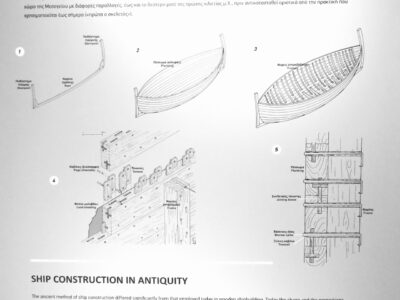Museum information posted: “SHIP CONSTRUCTION IN ANTIQUITY
The ancient method of ship construction differed significantly from that employed today in wooden shipbuilding. Today the shape and the proportions of a hull are primarily defined by the disposition of the wooden skeleton, namely the keel and the frames. Their assemblage is afterwards followed by the fastening of the planking to the frames.
In antiquity the shape of a hull was initially defined by the assemblage of the planking which initiated the construction. The ancient shipwright began the building of a ship by setting up the keel. Fig. 1
The stem and the sternposts were then mounted, and the builder began to shape the hull. Long planks on superimposed lines were attached on both sides to one end of the ship and, given the desired curve, fastened then to the other end. Fig. 2
Superimposed rows of planks were edge-joined and connected to each other with wooden tenons fitted into mortises cut in both edges of each individual plank. The joinery was finally held in place with treenails driven into holes, drilled after the tenons had been fitted into the planks. Fig. 3
Frames were inserted in the structure only after the external hull was completed to a certain extent, first the floor timbers followed by the half frames and the futtocks. Fig. 4
The attachment of the frames to the planking started with the drilling of holes through planking and each attached frame, and the insertion of long wooden treenails into the holes. Finally the wooden treenails were transfixed by bronze spikes, hammered from the external side of the planking. Fig. 5
This method of shipbuilding (“shell-first construction” was already well-known in the eastern Mediterranean during the Late Bronze Age and was dominant in several forms throughout the Mediterranean until the second half of the first millennium AD, before being gradually replaced by the method still used today (“skeleton first construction”).
From the 2013 “Το Ναυάγιο των Αντικυθήρων. Το Πλοίο, οι Θησαυροί, ο Μηχανισμός” (The Antikythera Shipwreck. The Ship, The Treasures, The Mechanism) at the National Archaeological Museum in Athens, Greece.


